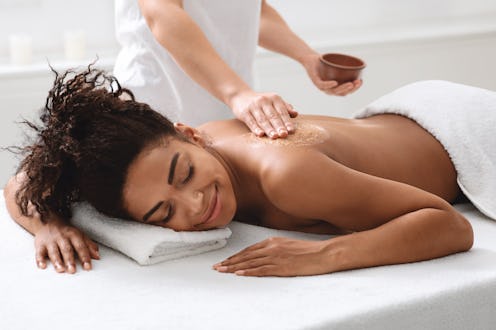Wellness
A Beginner's Guide To The Ayurvedic Panchakarma Cleanse
Experts explain the benefits of the Kourtney Kardashian-approved practice.

The word “cleanse” may bring to mind visions of green juice and saunas. But panchakarma, an Indian Ayurvedic cleansing method, involves a whole lot more than that.
You may have heard of it when Kourtney Kardashian told Bustle she’s been on it (“No sex for 12 days,” she said) or when Aaron Rodgers made headlines about doing the panchakarma cleanse. So, uh, what is panchakarma? In short, it’s a cleanse you can do for one to three weeks in order to reset and detoxify your body. It’s based on “five actions,” as Panchakarma means in Sanskrit, explains physician Dr. Avanti Kumar-Singh, and the goal is to remove waste and toxins, give your mind and body a rest, and realign your “digestive fire.” According to Kumar-Singh, that fire refers to the physiological process of digestion as well as the metaphorical ability to process all things coming into your system — energetically, emotionally, and spiritually.
To aid in these processes, panchakarma traditionally involves a 21-day treatment that incorporates things like bodywork, massage, and a specific diet. Oh, and abstaining from sex. The 360-approach this method takes is indicative of Ayurvedic medicine as a whole, which centers on finding balance through a holistic lifestyle.
Experts recommend working with a trained Ayurvedic practitioner when doing a panchakarma cleanse, as they’ll be able to assess any imbalances within your body and determine the best detoxification treatment for you. While it usually lasts 21 days, many people do aspects of the cleanse for anywhere from seven to 12 days. Here’s what to know about the Ayurvedic practice.
The Elements Of A Panchakarma Cleanse
The word panchakarma may mean five actions, says Kathryn Templeton, a board-certified Ayurvedic practitioner and medical advisor to The Body Agency, but the treatment program actually contains three core phases.
1. Pre-Cleanse
The first phase of panchakarma is purvakarma, or the pre-cleanse step, and it’s something that’s done by a professional. “This is a very important phase as it allows the waste and toxins to be loosened,” Templeton says. “This prep for panchakarma involves a steady stream of herbal oil to the forehead used to reduce stress, headaches, and support the nervous system.” A patient might also receive nasya, a nasal oiling that’s used to lubricate the nasal cavity, as well as abhyanga, an oil massage that’s done to help relax the body and support blood circulation.
2. Cleanse
For the second phase, a practitioner will utilize the five actions of panchakarma to detox the body. This is called pradhankarma, and it’s where the specific treatment protocol gets its name. Traditionally, these five actions include some pretty intense stuff — like enemas — which is why you 100% need to do panchakarma with the help of a trained practitioner. “You can do it at a panchakarma retreat, or you can also do a day's treatment and then go home,” says Beth Lauren, a certified wellness counselor and founder of Sangha NYC. Just don’t read info online and try it yourself.
There are, however, ways to “detox” on your own using tools pulled from an Ayurvedic lifestyle (à la Kardashian and Rodgers). Lauren recommends consuming foods that aid in digestion. Drink room temperature water, which is gentler on the body than cold water, and make soups that are easy for the body to process.
You might also eat more locally-sourced foods — another focus of Ayurveda — to receive the food’s good energy. Think fresh food that’s in season, versus food that’s been trucked across the country and left on a shelf. Other good food choices? Easy-to-digest rice, veggies, and oatmeal. “This is also something you might do before or after a panchakarma cleanse,” Lauren says, adding that an Ayurvedic cleanse is not about deprivation.
Some folks who practice Ayurveda may abstain from alcohol, cigarettes, and other drugs because they disrupt your brain chemistry, Lauren says, which isn’t very conducive to cleansing. You could also opt to abstain from sex, as mentioned above. Topically, Lauren adds it’s helpful to apply oils to your skin. “It's a really healthy, lovely Ayurvedic thing,” she says. “Any topical oil is so beneficial for your skin and for relaxation.” Consider hydrating botanical extracts with aromatherapy properties for a mind-body boost.
3. Post-Cleanse
After the cleansing element, a patient will move onto the final phase of panchakarma called paschaat karma, or the rebuilding phase. Instead of diving back into your usual diet, it’s recommended to focus on drinking liquids designed to restore “fire” to the digestive tract, now that it’s taken a break. “Then there is a more semi-solid diet consisting of highly nourishing foods and culinary spices, followed by solid food,” Templeton says. “If needed, there will be herbs and daily practices prescribed by the attending Ayurvedic doctor to support the client moving back into their lives with renewed vigor, health, and awareness.”
It’s very important to do this post-cleanse as prescribed by a practitioner, Templeton says, so that the tissues that have been detoxified can be properly nourished. This is often the time when a lot of people will decide whether or not they want to add certain foods or lifestyle habits back into their routine or continue on without them. The goal of this cleanse is, after all, to help you find a way to feel balanced.
Sources:
Dr. Avanti Kumar-Singh, physician
Kathryn Templeton, board-certified Ayurveda practitioner and medical advisor to The Body Agency
Beth Lauren, certified wellness counselor and founder of Sangha NYC
This article was originally published on